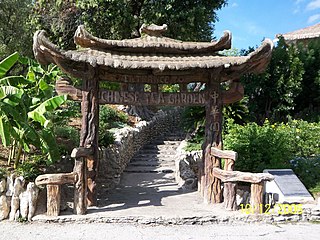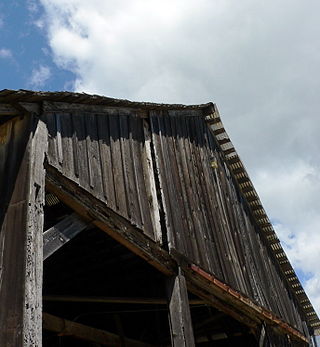
The Japanese Friendship Garden is a walled section of Kelley Park in San Jose, California, United States. Dedicated in October 1965, it is patterned after Japan's famous Korakuen Garden in Okayama and spans six acres. Its three main ponds were stocked with koi sent from Okayama in 1966. The ponds are at different elevations in the park, and are inter-connected by streams.

Thornden Park is a 76-acre (31 ha) park in Syracuse, New York, United States, which is the second largest in the city after Burnet Park. It was purchased by the city in 1921 and has become a favorite wedding location in the Syracuse park system. It is located in Westcott, and borders the University and University Hill neighborhoods. The park was listed on the National Register of Historic Places in 1994 as part of the Historic Designated Landscapes of Syracuse, New York.
Sunken Gardens may refer to:
Mahncke Park is an urban neighborhood and park located on the eastern fringe of Midtown San Antonio, Texas, USA.

The Japanese Tea Garden in San Francisco, California, is a popular feature of Golden Gate Park, originally built as part of a sprawling World's Fair, the California Midwinter International Exposition of 1894. Though many of its attractions are still a part of the garden today, there have been changes throughout the history of the garden that have shaped it into what it is today.

The San Antonio Botanical Garden is a 38-acre (150,000 m2), non-profit botanical garden in San Antonio, Texas, United States, and the city's official botanical garden.

The culture of San Antonio reflects the history and culture of one of the state's oldest and largest cities straddling the regional and cultural divide between South and Central Texas. Historically, San Antonio culture comes from a blend of Central Texas and South Texas (Southwestern) culture. Founded as a Spanish outpost and the first civil settlement in Texas, San Antonio is heavily influenced by Mexican American culture due to Texas formerly being part of Mexico and, previously, the Spanish Empire. The city also has significant German, Anglo, and African American cultural influences. San Antonio offers a host of cultural institutions, events, restaurants and nightlife in South Texas for both residents and visitors alike.
The city of San Antonio in the U.S. state of Texas is composed of a number of neighborhoods and districts, spreading out surrounding the central Downtown Area.

Dionicio Rodríguez (1891–1955) was a Mexican-born artist and architect whose work can be seen in Alabama, Arkansas, Illinois, Maryland, Michigan, New Mexico, Tennessee, and Texas, as well as Washington, D.C., and Mexico City.

The Cowell Lime Works, in Santa Cruz, California, was a manufacturing complex that quarried limestone, produced lime and other limestone products, and manufactured wood barrels for transporting the finished lime. Part of its area is preserved as the Cowell Lime Works Historic District, which was listed on the National Register of Historic Places in 2007. In addition to the four lime kilns, cooperage and other features relating to lime manufacture, the Historic District also includes other structures associated with the Cowell Ranch, including barns, a blacksmith shop, ranch house, cook house and workers' cabins. The 32-acre Historic District is located within the University of California, Santa Cruz campus, to either side of the main campus entrance.
Japanese Tea Garden may refer to:

Brackenridge Park is a 343-acre public park in San Antonio, Texas, USA, on the city's Broadway Corridor just north of downtown San Antonio.

The Guenther House is a restaurant, museum and store located at 205 E. Guenther Street in the King William neighborhood of the Bexar County city of San Antonio in the U.S. state of Texas. Currently operated by C. H. Guenther and Son. Inc., the home was originally built as a private residence in 1859 by Pioneer Flour Mills founder Carl Hilmar Guenther. It was listed on the National Register of Historic Places listings in Bexar County, Texas on October 11, 1990.
Eugene Edward (Gene) Lacritz was an American conductor, clarinetist, saxophonist, and a 31-year professional in management roles at four former specialty retail institutions, one in Houston and three in San Antonio. Notably, he was a senior executive — initially store manager and ultimately executive vice president — at Frost Bros., a former large apparel retail concern based in San Antonio.

The Conservation Society of San Antonio is located in the Bexar County city of San Antonio in the U.S. state of Texas. Founding members were Emily Edwards, who became the organization's first president, and Rena Maverick Green. The organization was formed on March 22, 1924, and officially incorporated on July 8, 1925. The Society is currently headquartered in the Anton Wulff House, which they saved from destruction in 1974. The home was built 1869–1870 by German immigrant Anton Wulff, who became the city's first Park Commissioner.

Brackenridge Park Golf Course is a historic golf course in San Antonio, Texas and the oldest 18-hole public golf course in Texas. It opened for play in 1916 and was the first inductee into the Texas Golf Hall of Fame. Brackenridge Park was the original site of the Texas Open which held the tournament for most years between 1922-1959. Located in historic Brackenridge Park, the course is one of six municipal golf courses managed by the non-profit management group, the Alamo City Golf Trail. The Alamo City Golf Trail consists of Brackenridge Park Golf Course, Cedar Creek Golf Course, Mission del Lago Golf Course, Olmos Basin Golf Course, Northern Hills Golf Course, Riverside Golf Course, San Pedro Driving Range and Par 3, and Willow Springs Golf Course.

George Washington Brackenridge was a philanthropist and the longest-serving Regent for the University of Texas. His donations of time, land holdings and wealth expanded the university and provided educational opportunities for women and other minorities. He was an advocate of women's suffrage and women's educational opportunities. He was also a business man who made his initial wealth as a profiteer during the Civil War. Brackenridge organized two banking institutions in San Antonio and served as their president. He was president of the San Antonio Water Works Company. Alamo Heights in Bexar County was once his residence and was named by him. His mansion Fernridge is now part of University of the Incarnate Word campus. Brackenridge Park, San Antonio Japanese Tea Garden and Mahncke Park in San Antonio were made possible through his donations of land holdings.

The Gate, Fence and Hollow Tree Shelter Designed by Dionicio Rodriguez is a work by noted artist Dionicio Rodriguez that is located at 320 Oak St. in Clayton, New Mexico. It consists of three faux bois sculptures created in 1943. Speculator Bayliss C. Froman commissioned the sculptures on his property after seeing Rodriguez's work on a visit to San Antonio. The sculptures include a gate resembling the entrance to the San Antonio Japanese Tea Garden, an intertwining log fence, and a hollow tree with textured bark.
Phil Hardberger Park is a public city park of San Antonio, Texas which opened in May 2010.

The Brackenridge Park Bridge is a historic iron Lenticular truss bridge located in San Antonio, Texas. The bridge was built in 1890 and remains open for vehicular and pedestrian traffic. Composed of a single truss of just over 95 feet (29 m), it is one of the shortest lenticular truss bridges in the country and one of just eight located west of the Mississippi River. The bridge is a contributing property to the Brackenridge Park Historic District, which was listed on the National Register of Historic Places in August 2011.
































